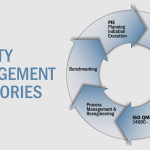Lean 101
This article provides an introductory level overview of Lean, which has experienced widespread use and success across both manufacturing and service sectors over many decades.Lean Defined
Lean is a philosophical way of working which emphasizes the removal of waste within a process. Core to this philosophy involves the principle that expenditure of resources for any goal other than the creation of value for the end customer is wasteful and therefore should be a target for elimination. This principle is applied from the perspective of the customer who consumes a product or service.
Value is commonly defined as any action or process that a customer would be willing to pay for. Put simply, Lean Process actively focuses upon preserving value with less work. The aim, therefore, is to create enhanced efficiencies resulting in improved process flow and ultimately increased speed across a process. Lean philosophies achieve this through applying a series of “tools” which assist in the identification and steady elimination of waste. As waste is eliminated, quality improves while production time and costs are also reduced. A Lean process emphasizes getting the right things to the right place at the right time in the right quantity to achieve perfect, sustainable work flow while minimizing waste and being readily adaptable to change.
Differences and Comparisons between Lean and Six Sigma
Six Sigma involves a customer centric methodology which focuses upon reducing the extent of variation that exists within manufacturing and/or service processes through rigorous data analysis in order to eliminate defects. The extent of customer centricity is reflected by the typically accepted Six Sigma definition of a defect being any process output that does not meet customer specifications. The term sigma originates from the Greek language, which refers to the standard deviation within a data set population. Incorporating statistical theory, Six Sigma in a process context involves the concept that six standard deviations between the process mean and the nearest specification limit will yield just 3.4 defects per million opportunities. Put another way, the process will perform defect free 99.99966 percent of the time. Both Lean and Six Sigma focus upon continuously improving processes.
Origins of Lean Principles
It is widely accepted that Lean principles originate from the Japanese manufacturing industry, with the term “Lean” first being used by Bob Hartman in his 1988 article, “Triumph of the Lean Production System.” The Toyota Production System (TPS), developed by the Japanese automotive manufacturer, is widely acknowledged as a key originator and influencer of contemporary Lean philosophy, particularly through the application of its Seven Wastes principles. From the 1990’s onward, an increasing number of both services and manufacturing organizations throughout the world have successfully incorporated the application of Lean within their businesses.
Key Lean Principles
The following items represent some of the most fundamental principles utilized within Lean philosophy:
The three different types of process value:
Value Adding
- Steps that are essential
- They physically change the product and service
- The customer is willing to pay for them
- They need to be done right the first time
Non-Value Adding
- Steps that are non-essential
- The product or service does not meet the customer’s needs
- The customer is not willing or able to pay for them
- Work is not done correctly the first time
Value Enabling
- Steps that are not essential to customers
- They allow value-added tasks to be done better and faster
- A different type of non-value added work for which the customer is not willing to pay for
An example of a value enabling activity within financial services involves obtaining a customer’s credit report. While a loan customer would not necessarily be prepared to pay for this activity, it does enable a more effective credit decision by the lender, resulting in acceptable levels of loan write offs and avoiding good customers having to pay higher rates of interest to cover excessive losses.
The Seven Wastes of Lean
The principles relating to the seven wastes of Lean involve the sub-optimal utilization of process resources and/ or activities. These were originally developed by Toyota’s Chief Engineer, Taiichi Ohno, as part of the Toyota Production System (TPS) and have been successfully applied within both manufacturing and services environments. These seven classical wastes of Lean are described as follows (also see the 8 areas of Waste outlined in our DOWNTIME article):
- Overproduction – Involves the principle whereby more resources than required to be delivered to your customer are expended. Overproduction is considered to be a particularly bad form of waste because it contributes to many of the others, especially excessive inventory.
- Unnecessary Transportation – Involves the principle whereby each time a product is moved, it stands the risk of being damaged, lost, delayed, etc., as well as being a cost for no added value.
- Excessive Inventory – Involves the principle whereby inventory, in any of its stages of use, represents a capital outlay that has not yet produced an income, either by the manufacturer or for the consumer. Inventory not being actively processed to add value is considered waste.
- Excessive Motion – As compared to Transportation, involves the principle whereby motion is considered in the context of the producer, worker or equipment. Excessive motion contributes towards increased risks of damage, wear and safety. It also extends to fixed assets and expenses incurred in the production process.
- Defects – Involves the principle whereby process defects result in additional costs ultimately being incurred in areas such as rework, repair, re-processing, rescheduling production, etc.
- Over-processing – Involves the principle whereby over-processing is considered to occur any time more work is performed upon a good or service than what is required by the customer. This includes using tools, materials and/or systems that are more precise, complex, excessive, or expensive than absolutely required.
- Waiting – Involves the principle whereby whenever goods are not in transport or being processed, they are waiting. This principle is also applied to workers who are waiting for something in order to perform a process or activity, etc.
5S
Originating from Japanese manufacturing practices, 5S refers to workplace organization principles which describe how key process resources are to be stored, along with how the supporting operating disciplines will be sustainably maintained. These are described:
- Sorting – Elimination of all unnecessary tools, parts and ancillary materials. Only essential items are retained within the work area, with everything else being stored or discarded.
- Straightening or Setting in Order – There should be a place for everything and everything should be in its place. The place for each item should be clearly labeled or marked. Items should be arranged in a manner that promotes efficient work flow. Each tool, part, supply, piece of equipment, etc. should be kept close to where it will be used in order to optimize the flow path.
- Sweeping or Shining or Cleanliness (Systematic Cleaning) – Keep the workplace tidy and organized. At the end of each shift, clean the work area and be sure everything is restored to its place. This makes it easy to know what goes where and ensures that everything is where it belongs. A key point is that maintaining cleanliness should be part of the daily work routine and not an occasional activity initiated when things become untidy.
- Standardizing – Work practices should be consistent and standardized. Everyone should know exactly what his or her respective and group responsibilities are for adhering to the first 3 S’s.
- Sustaining the Discipline – This involves ongoing maintenance and review of standards by the work group as the previous 4 S’s have been established as the only way to operate. This approach enables continuous improvement outcomes to be achieved through genuine engagement and participation with the workers.
While having originated from the Japanese manufacturing sector, Lean philosophies have been successfully applied across a myriad of manufacturing and services sectors the world over, delivering ($US) billions in organizational benefits as a result. Provided that Lean principles are correctly applied, with appropriate levels of executive level sponsorship, significant and sustainable improvements in manufacturing and service delivery efficiencies are capable of being realized.

